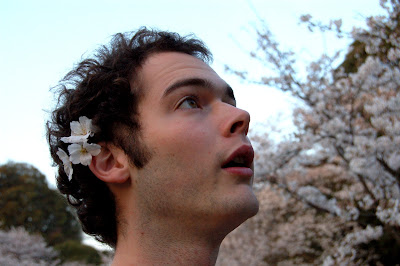Around the end of March, the Cherry trees burst into full bloom. They start in the far south, and move up Japan in a wave of flowers over the following week. So great is the custom of viewing the flowers, the Japanese weather agency publishes official forecasts of the specific blooming dates for each region. When the forecasters realised their prediction was out by a couple of days, they had to go on national TV and make a full apology, bowing and scraping in the way that only the Japanese can.
Sakura, the Japanese Cherry Blossom, is repeatedly fêted throughout Japanese culture, from the most austere of Haiku to the cheesiest of J-pop lyrics.
When those flowers finally emerged, it became perfectly clear what all the fuss is about.
 The bloom is radiant and lovely, to a gratuitous degree.
The bloom is radiant and lovely, to a gratuitous degree.WHY be that pretty?
Well, reason or no, the effect is wonderful, and manna to the soul.

The Japanese being one of the most civilised of peoples, they take the time to sit and watch the flowers, in viewing sessions known as Hana Mi. They have a long history; The Tale of Genji, written in the early eleventh Century, tells of flower viewing sessions much akin to Hana Mi.
Despite the traditions of Zen austerity that remain as one strand of Japanese culture, they are also extraordinarily good at enjoying the pleasures of life.
They do not just sit and watch in silence, in raptures of aesthetic wonder.
Instead, they get pissed.
Large groups, whether of friends, work colleagues, communities, sit on spread blue tarpaulins, and drink themselves into a flower covered alcoholic oblivion.
Keen to sample as much of Japanese culture as possible, we were keen to emulate our hosts example.
This was made easier by my discovery of a new, special can size of Asahi Beer.

A can of beer, bigger than an adult's head. God bless the Japanese.
At night, the parks of dense Cherry Blossom are floodlit and packed with revellers. Viewing cherry blossom at night is called 夜桜 (Yozakura); when a culture produces a single word to describe something, it shows that thing is important to those people (You may notice we don't have a single word for 'watching cherry blossom at night' in English.)
[Incidentally, my favourite untranslatable word is 'Uitwaaien' - Dutch for 'to walk in the wind for fun'.]
The week after our own Hana Mi, I was in Kyoto and found this beauty, its boughs heavily laden with blossom, standing strong and still, drawing all eyes to its treasures.
 Sakura is not just famous because of its great beauty. It also holds a great emotional draw because of its fleeting lifespan. For a week, the blossoms grow. Then they stand, proud and brilliant in full bloom, for one week more. And after that, it is all downhill.
Sakura is not just famous because of its great beauty. It also holds a great emotional draw because of its fleeting lifespan. For a week, the blossoms grow. Then they stand, proud and brilliant in full bloom, for one week more. And after that, it is all downhill. The blossom flies off in the wind. The ground becomes ankle deep in drifts of discarded cherry blossom.
The blossom flies off in the wind. The ground becomes ankle deep in drifts of discarded cherry blossom.A couple of weeks, and then it is all gone. Plain green leaves replace the bright blossom. The blossom on the floor shrivels to yellow dust.
In Japanese culture, the blossom is seen as the ultimate example of 物の哀れ ('Mono no aware'). Various translations exist, but it roughly means 'the pathos of the fleeting nature of existence'.
One week it is bright and brilliant, the next week it is gone.
It is a powerful reminder of the brevity of our time here.
So in the mean time, let's have a drink.
No comments:
Post a Comment